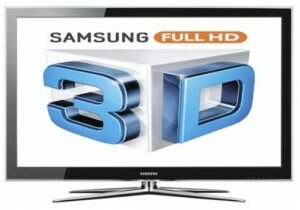Samsung Launching Full HD 3D Displays Using RealD Glasses
 Samsung have an ace up their sleeve in the debate over active 3D verses passive 3D – Full HD (to each eye) 3D display technology which works with passive glasses, thanks to a license agreement with RealD.
Samsung have an ace up their sleeve in the debate over active 3D verses passive 3D – Full HD (to each eye) 3D display technology which works with passive glasses, thanks to a license agreement with RealD.
Samsung Electronics LCD and RealD Inc have been developing the new 3D display technology for a while, which will be licensed to other manufacturers, starting with PC monitors makers.
RealD (who’s 3D projectors and glasses are used in thousands of cinemas around the globe) and Samsung, have developed an LCD based display system that incorporates the active shutter technology into the display rather than the glasses. Wearing the same circular polarised RealD glasses they get from a trip to the cinema, viewers will be able to enjoy a "brighter, flicker-free, fully immersive 3D experience across a wide viewing angle.”
Both companies are keen to highlight this new technology offers a full HD to each eye experience, which Samsung have argued is not achievable on LG’s Film-Patterned-Retarder passive 3D TV sets.
The new RealD 3D display technology wont be released until early 2012 where it will only be available for PC monitors in sizes of 23” and 27”. After the commercialisation of the PC monitors, the technology will be made available for 3D TV sizes of 55”.
The display panels are based on technology in the RealD cinema system utilised in cinemas. In a RealD cinema, a liquid crystal based polarisation modulating switch sits in front of the movie projector and alternately switches the polarisation of the image as it goes out of the projector to clockwise for right eye, counterclockwise for left eye. In the Real D glasses are two circular polarised lenses which correspond to the polarised left and right images bouncing off the silver screen. The new RealD TV technology works in a similar fashion. An LCD panel sits in front of the screen. As the screen displays each full HD left and right frame in sequence, the LCD panel actively syncs with the left and right eye images, circularly polarizing them in alternate directions. This allows for full resolution high definition 3D video to each eye using RealD 3D cinema glasses. RealD claim that this technology also allows for "no reduction of image quality in 2D mode, unlike FPR displays that darken 2D images or make text less sharp".
"RealD and Samsung's new displays look fantastic and represent the next step in 3D home entertainment," said James Cameron, a member of RealD's board of directors. "Full resolution viewing is key to experiencing 3D as a filmmaker intended, and when combined with the comfort and practicality of RealD 3D cinema glasses, this display technology will set a new standard for 3D in the home."
"3D displays should not compromise image quality by degrading resolution, it's simply not the premium viewing experience consumers have come to expect from 3D," said Bob Mayson, President of Consumer Electronics at RealD. "By working with Samsung to integrate active shutter technology on the panel, these displays deliver a full resolution 3D experience with the convenience and familiarity of RealD 3D cinema eyewear." You can watch an exclusive interview with Rob Mayson on
"We have been developing this advanced active 3D display technology with RealD for a long time and look forward to introducing displays with full resolution to each eye and a wide viewing angle so audiences can experience content as it was intended to be seen," said Wonkie Chang, President of Samsung Electronics LCD Business.
RealD and Samsung LCD Business will be showcase their RealD 3D display TVs, PC monitors and laptops in their booths at SID's Display Week 2011, May 17-19, 2011, at the Los Angeles Convention Center.
This is very exciting news for the 3D TV industry. Samsung have long been advocates of active 3D technology and it has allowed them to sell 3D TVs for as low as £500. The advantage of active 3D technology is that it can deliver full HD to each eye. However, active glasses are bulky, often lose sync, are expensive and create a horrible flicker effect. Passive glasses, as used with the LG Cinema 3D TV series, as reviewed by 3dfocus.co.uk, are light-weight, easy to wear and cheap. However, many argue that passive technology cuts the resolution in half (although LG have received certification from Intertek and the 3rd Institute in China that their Cinema 3D sets are full HD).
What has been needed is either an increase in resolution of passive 3DTV sets to 4K or something else. This is that “something else”. However, it also sounds like the technology could be expensive and the LG Cinema 3D range can already be bought for about £800. If the prices reaches an affordable price point, RealD 3D TV technology will finally offer the cinema 3D experience in the home without the current compromises.
FREE WEEKLY 3D NEWS BULLETIN –




















Pingback: Samsung Launching Full HD 3D Displays Using RealD Glasses | 3D … | www.1080p.it